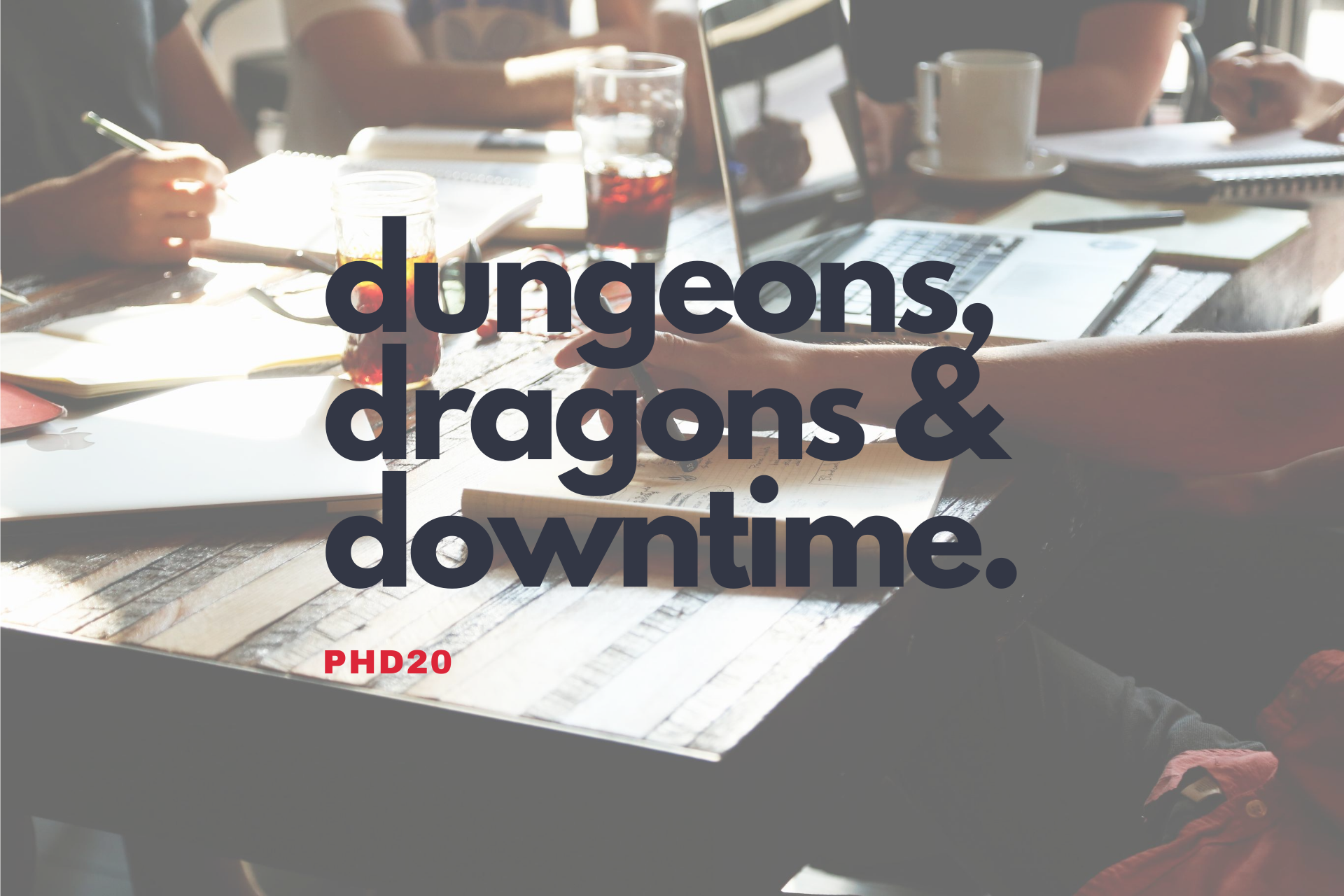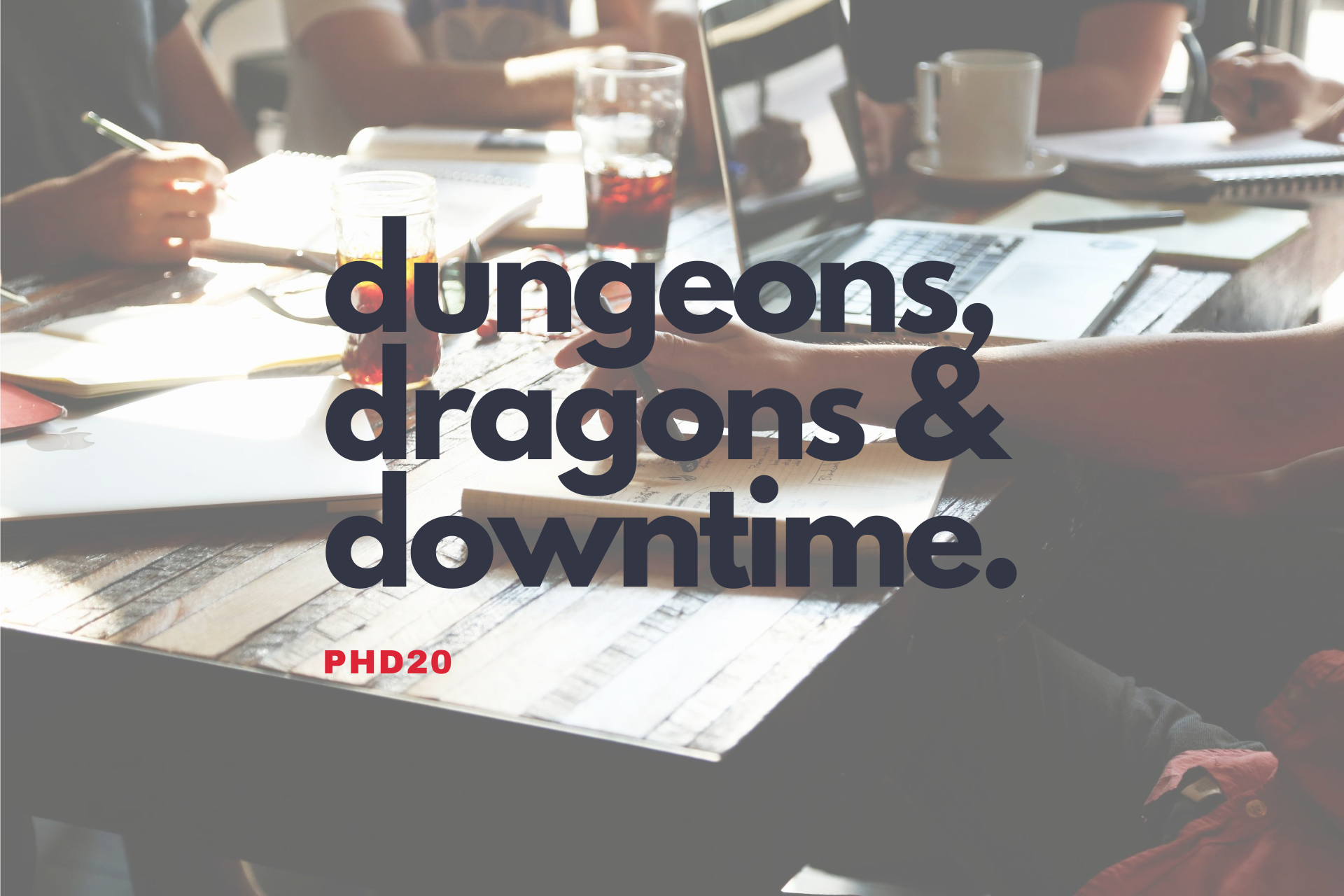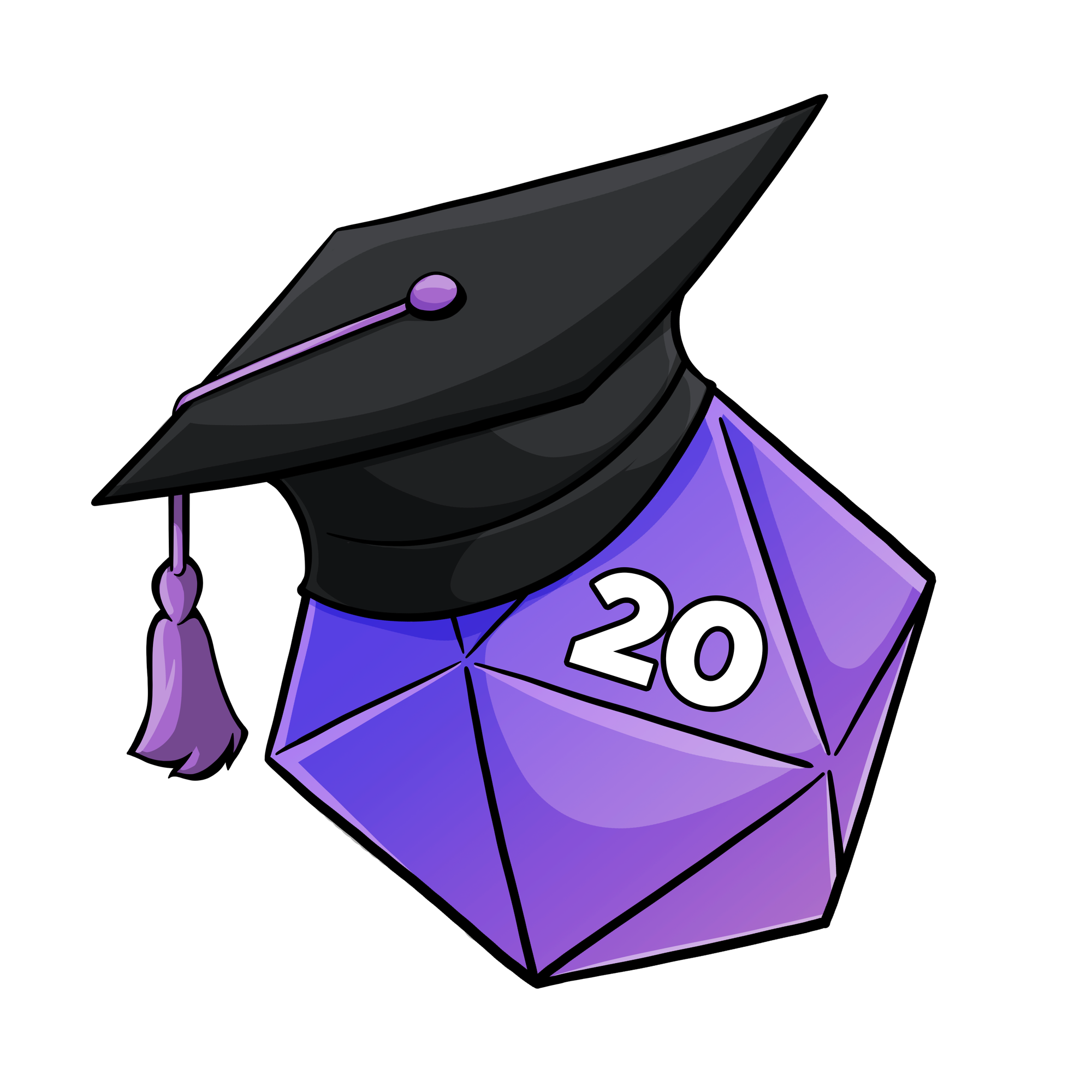Dungeons, Dragons, & Downtime

Downtime activities are a recurring theme in most D&D campaigns. Many 5E source books include rules for downtime activities. But how do you take those rules and run enjoyable downtime? Let’s find out.

D&D 5E defines Downtime Activities and rules in many sourcebooks. The Player’s Handbook first introduces Downtime Activities in Chapter 8: Adventuring. Here, we find a few examples of what players can do during downtime and the rules to help. The Dungeon Master’s Guide expands on these in Chapter 6: Between Adventures. It adds nine more activities and even rules for creating your own Downtime Activities. Lastly, Xanathar’s Guide to Everything provides an entire chapter on the subject (Chapter 2). This is the most exciting addition of the three I mention. It adds a host of activities and introduces Complications, a fun mechanic. More Downtime Activities exist but the ones listed here are a good starting point.
The first challenge in running interesting downtime is to understand the options available. I’d recommend compiling them into a single resource. I use Obsidian for my campaign notes. But any option in the Ultimate Guide to TTRPG Campaign Managers will work. Include the following:
- The name of the activity
- A brief summary of the rules involved
- The complications that could arise and the rules to determine those
A Note on Pacing
Organizing the rules will help you overcome the major challenge in running downtime. Pacing is challenging enough when the party is together and chasing the same goal. Downtime leads to split parties and varying goals. The paladin might want to relax at the spa while the warlock decides to enter a pit fighting competition. You no longer have a pace. You have a pace per player character. Spend too much time on the pit fighting and the paladin gets bored. We’ll discuss strategies for overcoming this challenge later throughout the article. But your best tool is a well-organized list of rules and options.
Timing of Downtime
When downtime happens matters. Downtime might start off a gaming session. But the dynamic changes when it’s at the end of a session. Let’s take a look at the options available and strategies to make the most of each.
Front-Loading Downtime
Downtime can occur at the beginning of a session. Let’s say the last session ended with the party arriving in town. This session starts with kicking off their adventuring boots. Time to explore the downtime opportunities in town. The last thing you want is for a dull start to a session. It becomes hard to engage the players and immerse them in the story. Downtime poses a risk here because you usually can’t engage the entire party at once. Especially, if each character goes their separate way in town. Research might be exciting for the wizard performing it. But it might bore the cleric who is performing a religious service. She’s not involved in the research so the dice rolls and information aren’t as important to her.
If you’re going to start a session with downtime, you have one major advantage. You know it’s coming. You can prepare. Take full advantage of this, getting your rules and available activities ready. Know where they can perform each activity. Define locations, NPCs, and items you may need for downtime. The Downtime Event (discussed later) becomes critical when front-loading a session with downtime.
Discovering the trigger for ending downtime is important. Especially, with the rest of the session still ahead of you. How long do the characters intend to stay in town or what their purpose here? Ask them. That way you can run downtime activities and know when to move on from them. If they’re staying in town a week to rest up, no problem. Let them know that these activities happen over the course of several days. When everyone’s done, let them know the week is over and it’s time to move on. If they’re in town to look for the ogre physician, downtime activities can lead them towards her. They might hear mention of her or spot her at the spa. But you know what or who to introduce to the party to move the narrative along after downtime.
If you don’t discover the trigger for ending downtime, it can drag on too long. Your responsibility as the DM is to make downtime fun while not sacrificing the rest of the story.
Back-Loading Downtime
Downtime can occur at the end of a session. You may or may not know this is coming. So be sure you have your normal rules organized and ready, as mentioned before. This is much simpler than starting a session because things are winding down. The important thing is to engage each character before ending the session. You don’t need to resolve everything but you want each to have declared their intentions. No one wants to feel left out as the session ends.
You also want expectations on the next session start to align. No one should expect to have more downtime if you’re going to jump right back in to the story narrative. Declare how it ends and how next session will start. It needs to be a group decision. So be sure to ask the party if that aligns with their expectations and their characters’ needs.
In the Middle
Downtime can occur in the middle of a session. This one’s tricky because it’s hard for pacing. You don’t want the middle of a session to be a complete drag. To combat that, start the session strong with combat or high tension. A chance to breathe and relax with downtime will feel more natural when it occurs mid-session. End the session on a high note. Cliffhangers are perfect. A few examples might help us visualize here.
Bad Example
The session starts with a travel montage as the party crosses a few dozen miles of dangerous lands. Whether by your good grace or lucky die rolls, they don’t encounter anything dangerous. They reach the destination city and begin downtime.
That montage was a slow moment for pacing since nothing happened. Following that with a slower-paced downtime makes for a long session as a player. Doesn’t matter how this example ends. If the travel montage was to be uneventful, it could have happened before the session started. That way, you transition to starting the session with the downtime and follow the tips above.
Better Example
The sessions starts with a travel montage as the party crosses a few dozen miles of dangerous lands. They defeat a few goblins at the start of the session. Before town, they’re met by a rival adventuring group. The group claims that the party stole something from them during the night. This leads to either a high-tension negotiation or resolves with outright combat. Either way, the party is more than ready for the safety of the city and downtime to breathe and regroup.
Alternative Approaches
Downtime Sessions
Downtime can occur throughout the entire session. This should only happen once or twice over the course of a years-long campaign. Think about the episode of Dragonball Z where Goku and Piccolo try to get their driver’s license. It’s fun and quirky but you wouldn’t want a lot of episodes like that.
Make sure your NPCs and locations are ready. Use a random generator if they come across an NPC you haven’t created yet. Since we’re using the entire session for downtime, it is the story. So make it interesting. Sow adventure hooks throughout the activities. Reveal more of your world, whether its secrets or lore. Show how the NPCs are engaging in their own downtime or even join the player characters. Allow for some hijinks from the party. Embrace complications and failures as tools to provide more story opportunity. As you do all this, be sure to engage the entire party throughout (something we’ll discuss to end the article).
Downtime Outside of the Game
Downtime can occur outside of a session. This is my personal favorite. Pacing is a non-issue. One of my groups plays in person (online for the time being thanks to COVID-19). Between sessions, we use a Discord server. I create a special channel for each player to roleplay 1-on-1 with me. I also create a channel for the location of the party while they’re engaging in downtime. Usually a city. This allows anyone to post in the city channel for group downtime activities. Or in personal channels if their character goes off on their own. They can explore the locations and engage in activities on their own time.
No one’s rushed. The players get my full attention on what they’re trying to do. I can take the time to share images of people, places, and so much more. So far, it’s worked out very well. Your only risk is players that don’t take advantage of communicating between sessions. I’d highly encourage you to give this method a try for some of your downtime.
The Downtime Event
Downtime should spark an interesting event each time it’s used. I’m not talking about combat or a chase scene. Maybe one party member crafts a better item than they were attempting. Now they can sell it or show others how to craft it. Maybe the paladin at the bath house witnesses a city priest engage in a shady exchange. The event should drop in a story hook or interesting lore about the setting. This helps prevent downtime activities from becoming stale, rote routines. Roll this, get that.
Be prepared with small bits of lore and interesting story hooks at all times.
Engaging the Entire Party
Let’s finish out our discussion on downtime with the most important piece. This section assumes you’re running downtime during a gaming session. With each player character performing different activities, we now face the challenge: pacing. As mentioned before, engaging one player’s downtime goals doesn’t usually engage another’s. To combat this, you’ll want to find ways to engage each player throughout.
Let’s look at the first approach. Say we have three players: Player A, Player B, and Player C. Start with each player declaring what they’d like to do during downtime. Then engage with each player, one at a time, for a short duration.
Player A wants to gamble. You briefly explain the rules and the options available in town. Player A picks the Harbor casino. You tell Player A to make the three appropriate ability checks. Then you look at Player B.
Player B wants to research. You briefly explain the rules and the options available in town. Player B picks the Stacks to look through their collections. You tell them how to make the appropriate ability check.
See the process? Repeat for Player C. Coming back around-
You ask Player A for the results of their checks. You narrate the results. Maybe the crowd is cheering them on a hot streak. Maybe they’re being watched by pit bosses. Toss in something interesting here. On to Player B-
You ask Player B for the result of the check. You narrate the results. If you’re prepared, maybe you have a handout ready with information on what they’re looking for. While they read over that you can proceed to Player C.
I’ll stop the repetitive examples but you can see how breaking it up into pieces allows you to engage each player often. Similar to combat, they know they have a “turn” coming up.
Another approach is to bring them together for each activity, when it fits. If Player C wants to do pit fighting, you might ask if the others are going to be in the crowd. If so, you can do a single scene focused on the pit fighter. Engage the other players by asking what they’re doing while in the crowd. Similarly, since Player B wants to research, you can ask if they’re doing it alone or if anyone is going to help them. This approach allows you to spend more time on each activity. But you can only use it when party members want to be together for the activity.
Regardless of the approach you take, make sure you’re engaging with each player many times. If a player wants to hang out at the tavern and wait for the others, start up a conversation with an NPC at the bar. Engage each player often.
Summary
Downtime activities are a fun piece of the puzzle in D&D. But they present challenges. Be prepared by knowing the rules. Understand that the “timing of downtime” matters and presents different opportunities for you as a Dungeon Master. Keep it interesting with a downtime “event” at least once every time the party engages in downtime. And remember to engage the entire party often.
